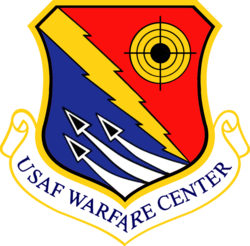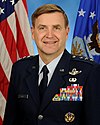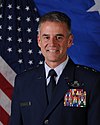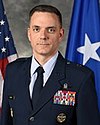United States Air Force Warfare Center
| United States Air Force Warfare Center | |
|---|---|
 Emblem of the United States Air Force Warfare Center | |
| Active | 1966–present |
| Country | United States |
| Branch | United States Air Force |
| Role | Warfare Training |
| Part of | Air Combat Command |
| Garrison/HQ | Nellis AFB, Nevada |
| Website | www |
| Commanders | |
| Commander | Maj Gen Christopher J. Niemi |
| Vice Commander | Brig Gen Jesse J. Friedel |
| Command Chief Master Sergeant | CCMSgt Emilio Hernandez |




The United States Air Force Warfare Center (USAFWC) at Nellis Air Force Base, Nevada, reports directly to Air Combat Command. The center was founded on 1 September 1966, as the U.S. Air Force Tactical Fighter Weapons Center. It was renamed the U.S. Air Force Warfare Center in 2005.[1]
Overview
[edit]The USAF Warfare Center manages advanced pilot training and integrates many of the Air Force's test and evaluation requirements. It was established in 1966 as the USAF Tactical Fighter Weapons Center which concentrated on the development of forces and weapons systems that were specifically geared to tactical air operations in conventional (non-nuclear) war and contingencies. It continued to perform this mission for nearly thirty years, undergoing several name changes in the 1990s. In 1991, the center became the USAF Fighter Weapons Center, and then the USAF Weapons and Tactics Center in 1992.[1]
The USAF Warfare Center uses the lands and airspace of the Nevada Test and Training Range (NTTR) – which occupies about three million acres (12,000 km2) of land, the largest such range in the United States, and another five-million-acre (20,000 km2) military operating area which is shared with civilian aircraft. The center also uses Eglin AFB, FL, range, which adds even greater depth to the center's capabilities, providing over water and additional electronic expertise to the center.[1]
The USAF Warfare Center oversees operations of the 57th Wing, the NTTR, and the 99th Air Base Wings at Nellis AFB, Nevada; the 53d Wing (with Geographically Separated Units at Tyndall AFB, Florida and Holloman AFB, New Mexico) and 350th Spectrum Warfare Wing at Eglin AFB, Florida; and the 505th Command and Control Wing at Hurlburt Field, Florida.[1]
Units
[edit]- 53d Wing (53 WG)
- The 53d Wing serves as the focal point for the combat air forces in electronic combat, armament and avionics, chemical defense, reconnaissance, command and control, and aircrew training devices.
- 57th Wing (57 WG)
- The 57th Wing is responsible for a variety of activities, such as Red Flag, which provides realistic training in a combined air, ground and electronic threat environment for U.S. and allied forces. It is also the parent unit for both the USAF Weapons School (USAFWS) and the USAF Air Demonstration Squadron, the latter better known as the United States Air Force Thunderbirds.
- Previously known as the 98th Range Wing (98 RANW), the military organization known as NTTR provides command and control of the actual Nevada Test and Training Range facility located north and northwest of Nellis AFB. The 25th Space Range Squadron (SRS) operates and maintains the Space Test and Training Range and is a subordinate unit the NTTR.
- 99th Air Base Wing (99 ABW)
- The 99th Air Base Wing is the host wing at Nellis AFB and manages the day-to-day operations of the base.
- 350th Spectrum Warfare Wing (350 SWW)
- 505th Command and Control Wing (505 CCW)
- The 505 CCW is dedicated to improving warfighter readiness through integrated training, tactics, and testing for operational-level command and control of air, space, and cyber power. It hosts the Air Force's only Air Operations Center Formal Training Unit (FTU).[1]
History
[edit]By the mid-1960s, USAF aircraft and aircrew losses in the Vietnam War had convinced Tactical Air Command (TAC) of the need to improve technical and operational skills for the widening conflict. TAC established the Tactical Fighter Weapons Center at Nellis Air Force Base, Nevada in 1966 for the expressed purpose of improving fighter operations and tactics. Nellis AFB had been referred to as the "Home of the Fighter Pilot" since the Korean War period of the early 1950s, and had a long history of conducting postgraduate fighter training and operational testing and evaluation of fighter weapons systems. Additionally, the Nellis Range, largest in the free world, readily complemented the new center's mission.
Lineage
[edit]- Established as the USAF Tactical Fighter Weapons Center in 1966
- Redesignated: USAF Fighter Weapons Center in 1991
- Redesignated: USAF Weapons and Tactics Center in 1992
- Redesignated: USAF Warfare Center in 2005.
Assignments
[edit]- Tactical Air Command, 1966 – 1992
- Air Combat Command, 1992 – present
Units assigned
[edit]Operational units assigned to the USAFWC have been:[2]
Wing
- 4545th Fighter Warfare Wing, 1966 – 22 August 1969
- 57th Fighter Weapons Wing (later 57th Tactical Training Wing, 57th Fighter Wing, 57th Wing), 22 August 1969 – present
- 350th Spectrum Warfare Wing - ?? - present
Groups
- 57th Fighter, 1 November 1991 – present
- 57th Test, 1 November 1991 – 1 October 1996
- 4440th Tactical Fighter Training (Red Flag)
- Attached 1 October 1979 – 28 February 1980
- Assigned 1 March 1980 – 1 November 1991
- 4443d Tactical Training: 26 January 1990 – 1 November 1991
Squadrons
- 64th Fighter Weapons (later, 64th Tactical Fighter Training Aggressor; 64th Aggressor): 15 October 1972 – 5 October 1990.
- 65th Fighter Weapons (later, 65th Tactical Fighter Training Aggressor; 65th Aggressor): 15 October 1969 – 7 April 1989.
- 66th Fighter Weapons: 15 October 1969 – 30 December 1981
- 414th Fighter Weapons: 15 October 1969 – 30 December 1981
- 422d Fighter Weapons (later, 422d Test and Evaluation): 15 October 1969 – 1 November 1991
- 431st Fighter Weapons (later, 431st Test and Evaluation): 1 October 1980 – 1 November 1991
- 433d Fighter Weapons: 1 October 1976 – 30 December 1981
- 4460th Helicopter: 1 November 1983 – 1 June 1985
- 4477th Test and Evaluation Flight (later, 4477th Test and Evaluation Squadron): 1 April 1977 – 15 July 1990
- USAF Air Demonstration Squadron: 15 February 1974 – present
Aircraft flown
[edit]
|
|
source[2]
List of commanders
[edit]| No. | Commander[3] | Term | |||
|---|---|---|---|---|---|
| Portrait | Name | Took office | Left office | Duration | |
| 1 | Major General Ralph G. Taylor Jr. | 1 September 1966 | 15 December 1969 | 3 years, 82 days | |
| 2 | Brigadier General Homer K. Hansen | 22 November 1969 | 23 July 1971 | 1 year, 243 days | |
| 3 | Major General William S. Chairsell | 23 July 1971 | 29 June 1973 | 1 year, 341 days | |
| 4 | Major General Gordon F. Blood | 29 June 1973 | 10 February 1975 | 1 year, 226 days | |
| 5 | Major General James A. Knight Jr. | 10 February 1975 | 12 June 1977 | 2 years, 122 days | |
| 6 | Major General James R. Hildreth | 12 June 1977 | 30 March 1979 | 1 year, 291 days | |
| 7 | Major General Robert E. Kelley | 30 March 1979 | 3 June 1981 | 2 years, 65 days | |
| 8 | Major General Jack I. Gregory | 3 June 1981 | 11 May 1983 | 1 year, 342 days | |
| 9 | Major General Eugene H. Fischer | 11 May 1983 | 13 July 1985 | 2 years, 63 days | |
| 10 | Major General Peter T. Kempf | 13 July 1985 | 21 June 1988 | 2 years, 344 days | |
| 11 | Major General Joseph W. Ashy | 21 June 1988 | 19 July 1989 | 1 year, 28 days | |
| 12 | Major General Billy G. McCoy | 19 July 1989 | 5 June 1992 | 2 years, 322 days | |
| 13 | Major General Thomas R. Griffith | 5 June 1992 | 21 July 1994 | 2 years, 46 days | |
| 14 | Major General Richard C. Bethurem | 21 July 1994 | 4 April 1996 | 1 year, 258 days | |
| 15 | Major General Marvin R. Esmond | 4 April 1996 | 7 July 1998 | 2 years, 94 days | |
| 16 | Major General Glen W. Moorhead III | 7 July 1998 | 31 January 2000 | 1 year, 208 days | |
| 17 | Major General Lawrence D. Johnston | 31 January 2000 | 25 June 2002 | 2 years, 145 days | |
| 18 | Major General Stephen G. Wood | 25 June 2002 | 4 October 2004 | 2 years, 101 days | |
| 19 | Major General Stephen M. Goldfein | 4 October 2004 | 6 October 2006 | 2 years, 2 days | |
| 20 | Major General R. Michael Worden | 6 October 2006 | 8 February 2008 | 1 year, 125 days | |
| 21 | Major General Stephen L. Hoog | 8 February 2008 | 18 May 2009 | 1 year, 99 days | |
| 22 | Major General Stanley T. Kresge[4] | 18 May 2009 | November 2010 | 1 year, 167 days | |
| 22 | Major General James W. Hyatt[5] | November 2010 | 20 July 2012 | 1 year, 262 days | |
| 23 | Major General Jeffrey G. Lofgren[6] | 20 July 2012 | January 2014 | 1 year, 165 days | |
| 24 | Major General Jay B. Silveria | 21 February 2014 | March 2016 | 2 years, 9 days | |
| 25 | Major General Glen D. VanHerck | March 2016 | 13 July 2017 | 1 year, 134 days | |
| 26 | Major General Peter E. Gersten[7] | 13 July 2017 | 2 June 2019 | 1 year, 324 days | |
| - | Brigadier General David W. Snoddy Acting | 2 June 2019 | 12 July 2019 | 40 days | |
| 27 | Major General Charles Corcoran[8] | 12 July 2019 | 18 June 2021 | 1 year, 341 days | |
| 28 | Major General Case Cunningham[9] | 18 June 2021 | 6 August 2024 | 3 years, 49 days | |
| 29 | Major General Christopher J. Niemi | 6 August 2024 | Incumbent | 144 days | |
References
[edit]![]() This article incorporates public domain material from the Air Force Historical Research Agency
This article incorporates public domain material from the Air Force Historical Research Agency
- ^ a b c d e "U.S. Air Force Warfare Center Fact Sheet". Archived from the original on 5 September 2015. Retrieved 24 March 2014.
- ^ a b "U.S. Air Force Historical Research Agency, 57th Wing". Archived from the original on 7 May 2011. Retrieved 2 October 2008.
- ^ "USAF Warfare Center (ACC)".
- ^ "Lieutenant General Stanley T. Kresge".
- ^ "Major General James W. Hyatt".
- ^ "Lieutenant General Jeffrey G. Lofgren".
- ^ "MAJOR GENERAL PETER e. GERSTEN > U.S. Air Force > Biography Display". Archived from the original on 24 February 2019. Retrieved 25 September 2020.
- ^ "Charles S. Corcoran".
- ^ "MAJOR GENERAL CASE A. CUNNINGHAM". Retrieved 20 June 2021.














![Stanley T. Kresge[4]](http://upload.wikimedia.org/wikipedia/commons/thumb/f/fd/LIEUTENANT_GENERAL_STANLEY_T._KRESGE_USAF.JPG/100px-LIEUTENANT_GENERAL_STANLEY_T._KRESGE_USAF.JPG)
![James W. Hyatt[5]](http://upload.wikimedia.org/wikipedia/commons/thumb/8/83/Maj_Gen_James_W._Hyatt_%281%29.jpg/100px-Maj_Gen_James_W._Hyatt_%281%29.jpg)
![Jeffrey G. Lofgren[6]](http://upload.wikimedia.org/wikipedia/commons/thumb/e/e3/Jeffrey_G._Lofgren_%282%29.jpg/100px-Jeffrey_G._Lofgren_%282%29.jpg)


![Peter E. Gersten[7]](http://upload.wikimedia.org/wikipedia/commons/thumb/3/37/Maj_Gen_Peter_E._Gersten.jpg/100px-Maj_Gen_Peter_E._Gersten.jpg)

![Charles Corcoran[8]](http://upload.wikimedia.org/wikipedia/commons/thumb/6/63/Charles_S._Corcoran_%284%29.jpg/100px-Charles_S._Corcoran_%284%29.jpg)
![Case Cunningham[9]](http://upload.wikimedia.org/wikipedia/commons/thumb/c/c9/Maj_Gen_Case_A._Cunningham.jpg/100px-Maj_Gen_Case_A._Cunningham.jpg)


